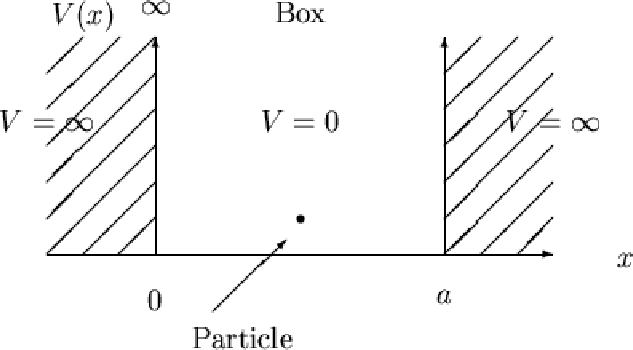Using the Schrodinger equation, what can we calculate?
1 Answer
In general, this equation is designed such that a unique Hamiltonian operator and wave function can be specified for a particular system. The most common thing we can obtain from the Schrodinger equation is the energy.
EXAMPLE
For example, take a single particle moving back and forth in a 1-dimensional box:

We start out with simply:
#hatHpsi = Epsi#
For this system, since the particle is said to move elastically horizontally, there is all kinetic and no potential energy.
The Hamiltonian is specified as:
#hatH = hatK + hatV#
#= -ℏ^2/(2m) grad^2 + V(x)#
where
OBTAINING THE SECOND-ORDER DIFFERENTIAL EQUATION
Plugging this into the starting equation, we solve for the second-order differential form of the Schrodinger equation for this system:
#-ℏ^2/(2m) d^2/(dx^2)psi(x) = Epsi(x)#
#(d^2psi(x))/(dx^2) = -(2mE)/(ℏ^2)psi(x)#
#bb((d^2psi(x))/(dx^2) + (2mE)/(ℏ^2)psi(x) = 0)#
This has now become a second-order differential equation for what is known as the particle in a box model, where the particle is in a well of infinite potential walls, with a closed interval
The above equation can be rewritten in an even more general form:
#(d^2psi(x))/(dx^2) + k^2psi(x) = 0#
SOLVING FOR k BY SETTING BOUNDARY CONDITIONS
The general solution to this situation for the wave function
#psi(x) = Acoskx + Bsinkx# ,
where
The boundary conditions for this system must be set for it to be physically meaningful (the particle must vanish at the boundaries of the system).
In this case,
#psi(0) = Acos(0) + cancel(Bsin(0))^(0)#
In order for the whole thing to go to
The second (consecutive) condition gives:
#psi(a) = Bsin(ka)#
Here, the physically-meaningful and nontrivial solution is that
USING k TO FIND THE ENERGY
Now if we plug back into the definition of
#k = (npi)/a = sqrt((2mE)/(ℏ^2))#
#(n^2pi^2)/a^2 = (2mE)/(ℏ^2)#
#=> color(blue)(E_n = (n^2pi^2ℏ^2)/(2ma^2) = (n^2h^2)/(8ma^2))#
So this is the energy for a particle elastically traveling back and forth in a confined, 1D box.
(Surprisingly, this can be applied to real systems, like butadiene, for example, or other conjugated
For completion's sake, as a sidenote, we would also obtain
#psi(x) = Bsin((npix)/a)#
and to get what
#1 = int_(0)^(a) psi^"*"(x)psi(x)dx#
#= int_(0)^(a)Bsin((npix)/a)Bsin((npix)/a)dx#
#= B^2 int_0^a sin^2((npix)/a)dx#
and eventually get that

